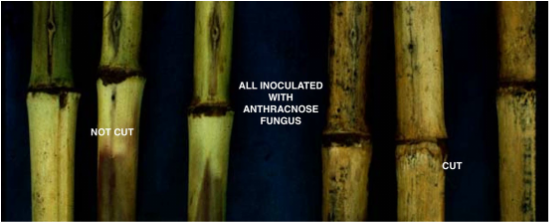|
We have established that plants dying early as a prelude to stalk rot, actually wilt because roots have rotted to the point that water transport to the upper part of the plant has stopped. This was caused because there was insufficient sugar to the root tissue. One difference between this plant and adjacent plants was more kernels on the dead plant. In our survey comparing dead and alive we noted one other difference. If a corn borer had caused the plant to break above the ear, that plant frequently had stalk rot. We eliminated those plants from the data because we wanted to emphasize the kernel number variable. Some would say that the corn borer allowed the stalk rotting fungus to enter the stalk but then why was the stalk broken below ear remaining solid? Ear was on ground but stalk penetration by fungi did not seem to destroy the remaining intact stalk.
If distribution of sugars affected early death of roots, wouldn’t reduction of the production of sugar after pollination do the same? Removing leaves after pollination did increase stalk rot in an experiment published in 1980. Five commercial hybrids in plots were included in the study. Every other plant in the plots was cut with at different nodes above or below the ear, or left uncut. All leaf removal was done at 2 weeks after pollination. 100% of plants with all leaves removed above the ear node developed stalk rot. Progressively few plants got stalk rot as fewer leaves above the ear were removed. On the other hand, no plants developed stalk if the plant was cut at the ear leaf including the ear. Very few had stalk rot if cut just below the ear. In a later experiment done with Herman Warren, then at Purdue, with plant stalks inoculated with the anthracnose fungus, Colleotrichum graminicola, showed that the disease increased with cut stalks also. Comments are closed.
|
About Corn JournalThe purpose of this blog is to share perspectives of the biology of corn, its seed and diseases in a mix of technical and not so technical terms with all who are interested in this major crop. With more technical references to any of the topics easily available on the web with a search of key words, the blog will rarely cite references but will attempt to be accurate. Comments are welcome but will be screened before publishing. Comments and questions directed to the author by emails are encouraged.
Archives
December 2021
Categories
|

 RSS Feed
RSS Feed